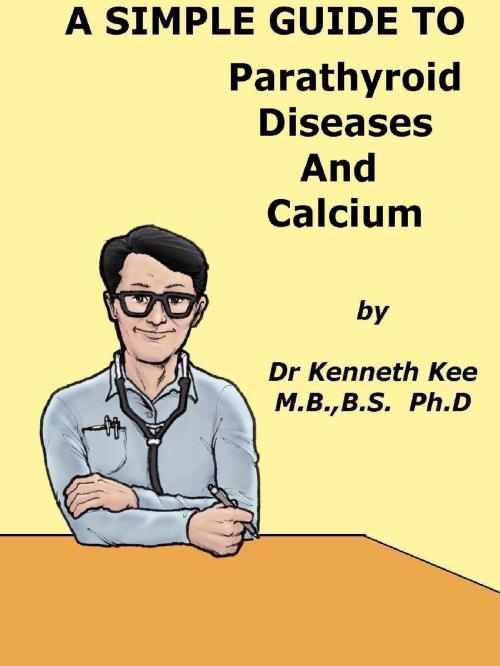A Simple Guide to Parathyroid Diseases and Calcium
Nonfiction, Health & Well Being, Medical, Specialties, Internal Medicine, Endocrinology & Metabolism, Ailments & Diseases, Diseases| Author: | Kenneth Kee | ISBN: | 9781301802760 |
| Publisher: | Kenneth Kee | Publication: | October 7, 2013 |
| Imprint: | Smashwords Edition | Language: | English |
| Author: | Kenneth Kee |
| ISBN: | 9781301802760 |
| Publisher: | Kenneth Kee |
| Publication: | October 7, 2013 |
| Imprint: | Smashwords Edition |
| Language: | English |
Chapter 1
Parathyroid Diseases
The parathyroid glands are located at the back of the Thyroid glands in humans and produce the parathyroid hormone.
They are the size of a grain of rice.
There are usually four parathyroid glands, which are usually located on the rear surface of the thyroid gland or within the thyroid gland itself or in the chest.
The Parathyroid hormones control the amount of calcium in the blood and within the bones so that the nervous and muscular systems can function properly.
If the calcium level drops in the blood, the parathyroid gland will sense it and release the parathyroid hormone which will then goes to the cells of the bone to take the calcium out and place it in the blood stream so that the calcium level becomes normal again.
The parathyroid glands do not have any connection with activity of the thyroid glands.
What are Parathyroid Diseases?
Parathyroid Diseases are diseases that can affect the level of calcium in the blood.
Some Parathyroid Diseases are:
- Hyperparathyroidism- an overgrowth of one of the parathyroid glands resulting in excess parathyroid hormones being produced.
This results in excessive calcium level in the blood.
Excessive calcium in the blood can affect
a. the nerves resulting in fatigue and depression
b. the bones resulting in bone pain
c. the heart resulting in abnormal heart beats and high blood pressure
d. the kidney resulting in kidney stones
- Hypoparathyroidism- occurs rarely at birth or when damage or removal of the parathyroid gland occur during surgery on the thyroid gland or parathyroid gland
Chapter 2
Hyperparathyroidism
What is Hyperparathyroidism?
Hyperparathyroid disease is a condition when the parathyroid gland produces too much parathyroid hormones resulting in hypercalcemia.
What are the causes of Hyperparathyroidism?
Hyperparathyroid disease is caused by:
Primary
-
Parathyroid hyperplasia
-
Parathyroid tumors such as adenoma or carcinoma
-
Excess parathyroid hormones leads to hypercalcemia from bone resorption, decreased renal excretion and increased intestinal absorption of calcium.
-
Bone changes, nephrocalcinosis, and corneal calcifications
Secondary.
Found in conditions causing hypocalcemia such as :
-
Renal failure
-
Vitamin D deficiency
-
Malabsorption syndrome
What are the symptoms of Hyperparathyroidism?
Symptoms:
Primary Hypercalcemia gives rise to:
- Digestive conditions:
a. anorexia
b. nausea and vomiting
c. constipation
d. pancreatitis
- Nerve Conditions:
a. proximal muscle weakness
b. depression
- Bone conditions:
a. bone pain
b. osteoporosis
- Heart conditions
a. Abnormal rhythms of the heart
b. hypertension
- Kidney conditions:
a. kidney stones
b. frequent passing of urine
- Secondary Hyperparathyroidism can give rise to:
a. ectopic calcifications in bones, kidney or gall bladder
b. backache
Some patients may be asymptomatic.
Chapter 1 Parathyroid Diseases
Chapter 2 Hyperparathyroidism
Chapter 3 Hypoparathyroidism
Chapter 4 High Calcium
Chapter 5 Low Calcium
Chapter 1
Parathyroid Diseases
The parathyroid glands are located at the back of the Thyroid glands in humans and produce the parathyroid hormone.
They are the size of a grain of rice.
There are usually four parathyroid glands, which are usually located on the rear surface of the thyroid gland or within the thyroid gland itself or in the chest.
The Parathyroid hormones control the amount of calcium in the blood and within the bones so that the nervous and muscular systems can function properly.
If the calcium level drops in the blood, the parathyroid gland will sense it and release the parathyroid hormone which will then goes to the cells of the bone to take the calcium out and place it in the blood stream so that the calcium level becomes normal again.
The parathyroid glands do not have any connection with activity of the thyroid glands.
What are Parathyroid Diseases?
Parathyroid Diseases are diseases that can affect the level of calcium in the blood.
Some Parathyroid Diseases are:
- Hyperparathyroidism- an overgrowth of one of the parathyroid glands resulting in excess parathyroid hormones being produced.
This results in excessive calcium level in the blood.
Excessive calcium in the blood can affect
a. the nerves resulting in fatigue and depression
b. the bones resulting in bone pain
c. the heart resulting in abnormal heart beats and high blood pressure
d. the kidney resulting in kidney stones
- Hypoparathyroidism- occurs rarely at birth or when damage or removal of the parathyroid gland occur during surgery on the thyroid gland or parathyroid gland
Chapter 2
Hyperparathyroidism
What is Hyperparathyroidism?
Hyperparathyroid disease is a condition when the parathyroid gland produces too much parathyroid hormones resulting in hypercalcemia.
What are the causes of Hyperparathyroidism?
Hyperparathyroid disease is caused by:
Primary
-
Parathyroid hyperplasia
-
Parathyroid tumors such as adenoma or carcinoma
-
Excess parathyroid hormones leads to hypercalcemia from bone resorption, decreased renal excretion and increased intestinal absorption of calcium.
-
Bone changes, nephrocalcinosis, and corneal calcifications
Secondary.
Found in conditions causing hypocalcemia such as :
-
Renal failure
-
Vitamin D deficiency
-
Malabsorption syndrome
What are the symptoms of Hyperparathyroidism?
Symptoms:
Primary Hypercalcemia gives rise to:
- Digestive conditions:
a. anorexia
b. nausea and vomiting
c. constipation
d. pancreatitis
- Nerve Conditions:
a. proximal muscle weakness
b. depression
- Bone conditions:
a. bone pain
b. osteoporosis
- Heart conditions
a. Abnormal rhythms of the heart
b. hypertension
- Kidney conditions:
a. kidney stones
b. frequent passing of urine
- Secondary Hyperparathyroidism can give rise to:
a. ectopic calcifications in bones, kidney or gall bladder
b. backache
Some patients may be asymptomatic.
Chapter 1 Parathyroid Diseases
Chapter 2 Hyperparathyroidism
Chapter 3 Hypoparathyroidism
Chapter 4 High Calcium
Chapter 5 Low Calcium















